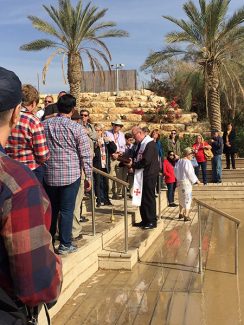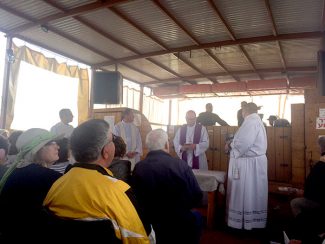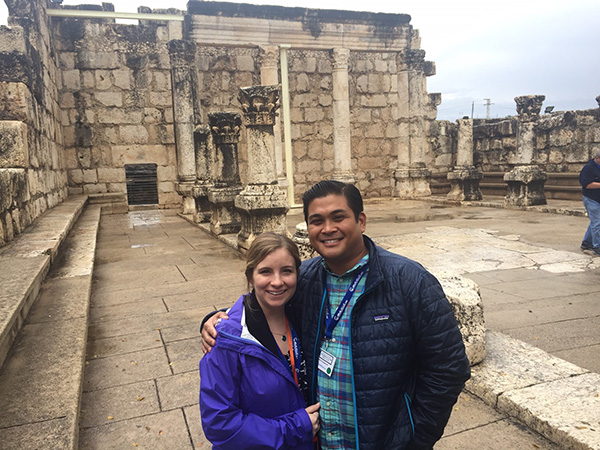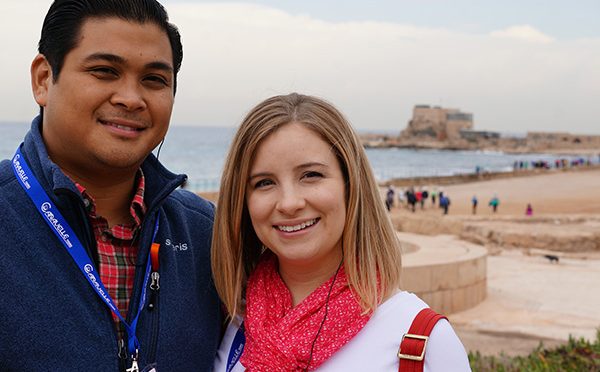
Newman University Director of Student Activities Lauren Fontarum returned from a weeklong pilgrimage to the Holy Land on Dec. 8. She was one of more than 100 people from the Catholic Diocese of Wichita, including Bishop Carl A. Kemme, to visit Israel’s significant Christian sites including Jerusalem, Bethlehem, Nazareth, and the Sea of Galilee among many others.
According to Fontarum, the purpose of the pilgrimage was to “witness and contemplate the life of Christ in the land from which he came and began his ministry.”
The celebration of the birth of Jesus makes the Holy Land a popular destination during the month of December.
“The pilgrimage was guided by two Christian guides based in Israel,” Fontarum explained. “With them, we visited and prayed at numerous churches and significant sites in the life of Christ. Because of the time of year, the Church of the Nativity was particularly fascinating. We were able to descend into the cave in which Christ was born and which has been recognized as his birthplace since the first century.”

Fontarum talked about her experience while on the Sea of Galilee as the group celebrated Mass on a boat in the middle of the sea. After Mass was finished, an enormous storm rolled in bringing hail and crashing waves.
“Everyone was drenched,” said Fontarum. “Personally, the experience opened the scriptures and the experience of the disciples in an incredible way, especially the story in Mark, Chapter 4 about Jesus calming the storm on the sea.”
Other highlights included a stop at Bethlehem University, a Catholic university in Palestine; an adoration hour in the Garden of Gethsemane; renewing baptismal vows at the Jordan River; wading in the Dead Sea; and Mass each day at different locations and chapels.
Fontarum added, “I also loved seeing the ancient ruins of old Jerusalem and the caves in which the Dead Sea Scrolls were found.”
The most unusual aspect of the Holy Land for me was embracing the various cultures and traditions of the people of Israel.
– Lauren Fontarum

“Evidence of those groups’ religious customs and culture were everywhere, and I enjoyed speaking with local people about their normal way of life,” said Fontarum. “The most unusual aspect of the Holy Land for me was embracing the various cultures and traditions of the people of Israel.”
While the mission of the trip was driven from a Catholic perspective, the group was able to demonstrate their beliefs freely alongside other faiths. The group visited the Western Wall, the most holy site of the Jewish faith. Many Jewish people prayed at the wall while the members of the Wichita Diocese prayed next to them.
“The men and women were separated and asked to cover their heads,” said Fontarum. “I touched the wall and placed my written prayer on the ground, but the most meaningful part for me was watching the people practice their faith and devotion so publicly and devotedly.”

Despite the ongoing conflict between Israel and Palestine, the group safely passed through the borders of the West Bank several times to visit the many Christian holy sites.
“Our group was never in danger,” Fontarum noted. “Israel was a welcoming, beautiful, and fascinating country and I would encourage anyone to make it a priority to visit.”
Near the end of the trip, the entire group walked the Via Dolorosa (Way of Sorrow) that marks Jesus’ journey from his sentencing to death to the place of the crucifixion. Bishop Carl Kemme led the group through the streets of Jerusalem and prayed at the Stations of the Cross.
Fontarum responded to being asked what she would like others to take away from her trip:
Our guide mentioned that Jerusalem is the proverbial home for all Jews across the planet, and represents the third most holy site for Muslims. Christians, he said, do not see Jerusalem in the same way. In order for the significant Christian holy sites to survive, we should make others aware of the situation and encourage greater focus on the Holy Land in general.
Being there has deepened my faith and affected my worldview in noteworthy ways. I hope that others will take time to investigate and learn about the importance of the holy sites for all the religions, as they cannot be found anywhere else in the world, and are the most significant for Christianity, as well as Judaism and Islam. We cannot afford to lose sight of these incredible and historic places.

